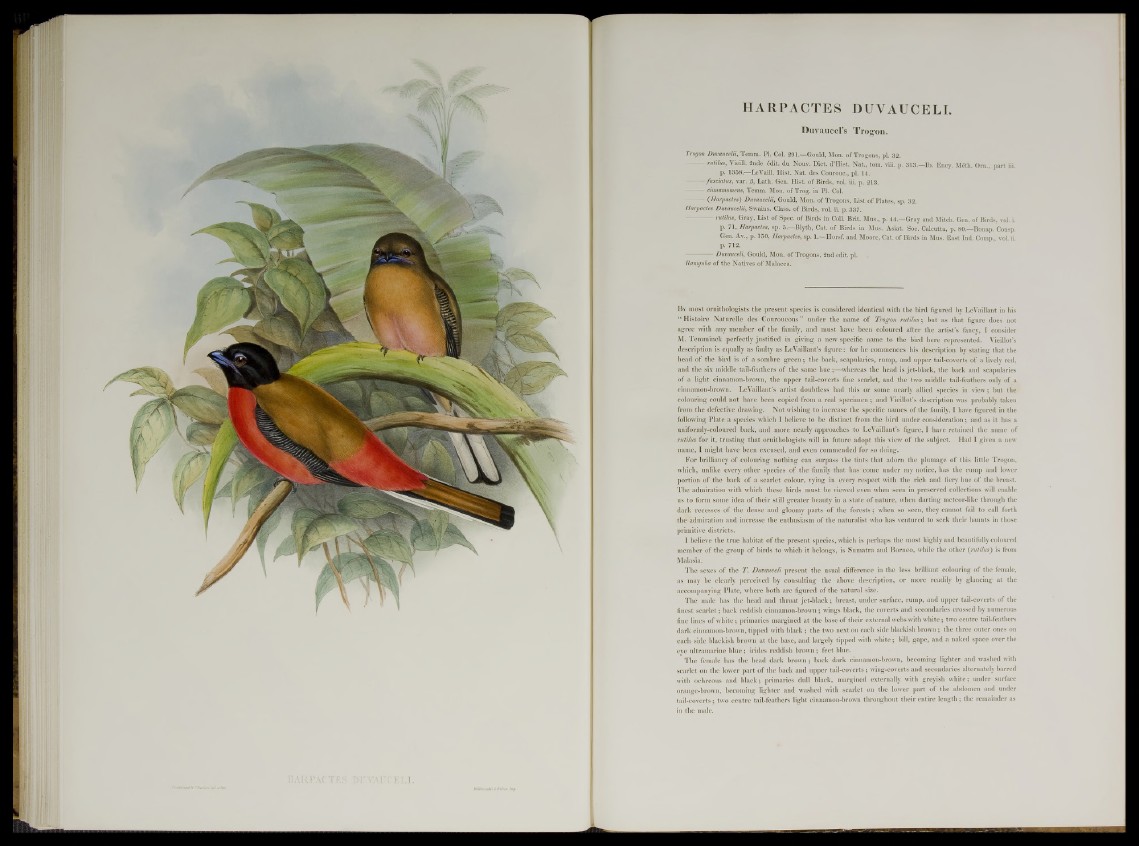
Duvaucel’s Trogon.
Trogon Duvaucelii, Temm. PI. Col. 291.—Gould, Mon. of Trogons, pi. 32.
— rutilus, Vieill. 2nde edit, du Nouv. Diet. d’Hist. Nat., tom. viii. p. 313.—Ib. Ency. Méth. Om., p art iii.
p. 1358.—LeVaill. Hist. Nat. des Courouc., pi. 14.
fasciatus, var. ¿3, Lath. Gen. Hist, of Birds, vol. iii. p. 213.
— cinnamomeus, Temm. Mon. of Trog. in PI. Col.
— (Harpactes) Duvaucelii, Gould, Mon. of Trogons, List of Plates, sp. 32.
Harpactes Duvaucelii, Swains. Class, of Birds, vol. ii. p. 337.
— rutilus, Gray, List of Spec, of Birds in Coll. Brit. Mus., p. 44.—Gray and Mitch. Gen. of Birds, vol. i.
p. 71, Harpactes, sp. 5.—Blyth, Cat. of Birds in Mus. Asiat. Soc. Calcutta, p. 80.—Bonap. Consp.
Gen. Av., p. 150, Harpactes, sp. 1.—Horsf. and Moore, Cat. o f Birds in Mus. East Ind. Comp., vol.ii.
p. 712.
— Duvauceli, Gould, Mon. of Trogons, 2nd edit. pi.
Ramguba of the Natives of Malacca.
B y most ornithologists the present species is considered identical with the bird figured by LeVaillant in his
“ Histoire Naturelle des Couroucous ” under the name of Trogon rutilus; but as that figure does not
agree with any member of the family, and must have been coloured after the artist’s fancy, I consider
M. Temminck perfectly justified in giving a new specific name to the bird here represented. Vieillot’s
description is equally as faulty as LeVaillant’s figure: for he commences his description by stating that the
head of the bird is of a sombre green; the back, scapularies, rump, and upper tail-coverts of a lively red,
and the six middle tail-feathers of the same hue;—whereas the head is jet-black, the back and scapularies
of a light cinnamon-brown, the upper tail-coverts fine scarlet, and the two middle tail-feathers only of a
cinnamon-brown. LeVaillant’s artist doubtless had this or some nearly allied species in view; but the
colouring could not have been copied from a real specimen ; and Vieillot’s description was probably taken
from the defective drawing. Not wishing to increase the specific names of the family, I have figured in the
following Plate a species which I believe to be distinct from the bird under consideration; and as it has a
uniformly-coloured back, and more nearly approaches to LeVaillant’s figure, I have retained the name of
rutilus for it, trusting that ornithologists will in future adopt this view of the subject. Had I given a new
name, I might have been excused, and even commended for so doing.
For brilliancy of colouring nothing can surpass the tints that adorn the plumage of this little Trogon,
which, unlike every other species of the family that has come under my notice, has the rump and lower
portion of the back of a scarlet colour, vying in every respect with the rich and fiery hue of the breast.
The admiration with which these birds must be viewed even when seen in preserved collections will enable
us to form some idea of their still greater beauty in a state of nature, when darting meteor-like through the
dark recesses of the dense and gloomy parts of the forests; when so seen, they cannot fail to call forth
the admiration and increase the enthusiasm of the naturalist who has ventured to seek their haunts in those
primitive districts.
I believe the true habitat of the present species, which is perhaps the most highly and beautifully coloured
member of the group of birds to which it belongs, is Sumatra and Borneo, while the other (rutilus) is from
Malasia.
The sexes of the T. Duvauceli present the usual difference in the less brilliant colouring of the female,
as may be clearly perceived by consulting the above description, or more readily by glancing at the
accompanying Plate, where both are figured of the natural size.
The male has the head and throat jet-black; breast, under surface, rump, and upper tail-coverts of the
finest scarlet; back reddish cinnamon-brown ; wings black, the coverts and secondaries crossed by numerous
fine lines of white; primaries margined at the base of their external webs with white; two centre tail-feathers
dark cinnamon-brown, tipped with black; the two next on each side blackish brown ; the three outer ones on
each side blackish brown at the base, and largely tipped with white; bill, gape, and a naked space over the
eye ultramarine blue; irides reddish brown; feet blue.
The female has the head dark brown; back dark cinnamon-brown, becoming lighter and washed with
scarlet on the lower part of the back and upper tail-coverts; wing-coverts and secondaries alternately barred
with ochreous and black; primaries dull black, margined externally with greyish white; under surface
orange-brown, becoming lighter and washed with scarlet on the lower part of the abdomen and under
tail-coverts; two centre tail-feathers light cinnamon-brown throughout their entire length; the remainder as
in the male.